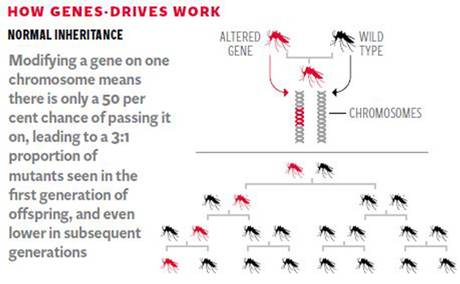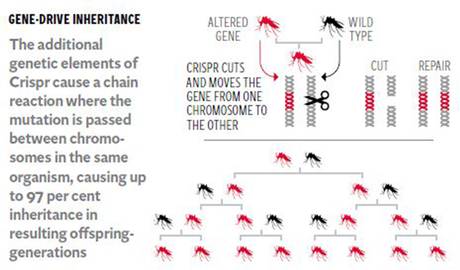
New GMO "gene drive" technology could be used to unleash the world's most devastating biological weapon
Ethan A. Huff, staff wroter
(NaturalNews) The next generation of genetically engineered life will more than likely possess a novel trait known as "gene drive" that literally spreads gene alterations like a virus within the host population, whether it is a plant or an animal. Many scientists are starting to worry that if it is placed into the wrong hands, the self-replicating technology could eventually turn GMOs (genetically-modified organisms) into covert bio-weapons for destroying food crops, livestock and even humans.
Gene drive is the scientific community's latest attempt to domesticate Mother Nature and eliminate undesirable issues such as mosquito-borne illnesses -- or at least that's what we're being told. The Independent (U.K.) says that gene drive technology has the potential to "address global problems in health," but it also warns that gene drive has the potential to worsen global problems in health, not to mention contaminate the entire food chain with irreversible GM traits.
In a letter in the peer-reviewed journal Science, a cohort of 27 leading geneticists has urged the scientific community to take a step back and consider the ways in which gene drive technology poses serious risks to human health and the environment. In essence, the technology gives genetic butchers the ability to ignite a chain reaction of genetic changes that can't be stopped, effectively transforming an entire population of life within just a few generations.
"Just as gene drives can make mosquitos unfit for hosting and spreading the malaria parasite, they could conceivably be designed with gene drives carrying cargo for delivering lethal bacterial toxins to humans," warns David Gurwitz, a geneticist from Tel Aviv University in Israel.
Gene drive technology artificially speeds up the spread rate of GM traits
Under normal circumstances, altered genes only have about a 50 percent chance of being passed on to future generations. A visual diagram published by The Independent illustrates this, showing how even over the course of several generations of exposure, genetically altered mosquitoes only pass their traits on to a small percentage of their offspring, preserving wild-type features within its population to some degree.

Gene-drive inheritance, on the other hand, is an entirely different animal. Gene-drive alterations are artificially sped up to promote more rapid changes within a population, so they infect many more organisms at a much faster rate. Gene-drive inheritance also spreads GM traits much more quickly within a single organism, resulting in a nearly total transformation within just a few subsequent generations, as illustrated in the following diagram from The Independent:

"The additional genetic elements of Crispr (a type of gene drive technology) cause a chain reaction where the mutation is passed between chromosomes in the same organism, causing up to 97 per cent inheritance in resulting offspring-generations," explains The Independent about gene-drive inheritance.
CRISPR gene-editing technique can be done for just $30, Nature paper admits
CRISPR, as explained in a recent feature article published in Nature, is a "cheap, quick, and easy to use" gene editing method that involves the delivery of an enzyme known as Cas9 into the target DNA of a given organism. Once there, this enzyme proceeds to edit the DNA to either disrupt target genes or insert desired consequences into them, a process that costs as little as $30.
The paper refers to the technology in terms of it being "democratized," meaning it's available to nearly everyone who wants it and knows what to do with it. Experts warn that this is one of the primary reasons it is considered immensely dangerous.
"The two applications of CRISPR technology that I'm the most worried about are edits to human reproductive tissue and the generation of and release into the wild of transgenic organisms that are capable of propagating edits," writes Brian Farley, a molecular biologist from the University of California, Berkeley, in response to a Quora question about the dangers or threats of CRISPR technology.
"If we generate successfully edited sperm or eggs and then use them for in vitro fertilization, we'll create individuals that carry those edits in every single cell of their bodies."
Sources for this article include:
http://www.naturalnews.com/z051315_CRISPR_gene_drive_technology_GMOs.html
